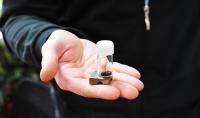WUT research results in a renowned chemical journal
A scientific article authored by researchers from the Faculty of Chemistry was published in "Chemical Communications" from the first decile of journals (200 points). The article presents research on a solution for removal of toxic caesium from aqueous solutions.
The element is present where there are nuclear power station failures. In various forms it is used, for example, for cancer treatment, in the pharmaceutical industry and even diet supplements, but it is harmful both for people and the environment.
How to dispose of caesium toxicity? Artur Kasprzak, PhD, started using sumanene for this purpose – a relatively new and unknown compound. A few months ago we described his research in the text "An idea for effective removal of the radioactive element". Now there is a continuation.
The research results were published in the August edition of "Chemical Communications". The authors of the article "A sumanene-containing magnetic nanoadsorbent for the removal of caesium salts from aqueous solutions" are Artur Kasprzak, PhD, Magdalena Matczuk, PhD (both from the Warsaw University of Technology Faculty of Chemistry) and Professor Hidehiro Sakurai (from Osaka University).
Submission of the publication was invited during preparation of "2023 Emerging Investigators" – an annual special collection distinguishing research of promising scientists at early stages of their independent careers, who make a significant contribution to their fields. Moreover, the article was on the cover of the July edition.
Do have a read! The article is available in open access here.








